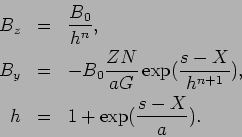The D magnet's bending power dominates
![]() in the HKS magnets over Q1 and Q2, therefore
the field map of D is the most crucial for the momentum resolution of the HKS.
In order to estimate how good a field map is required for the D magnet,
we performed a Monte Carlo simulation with artificially deteriorated field maps.
The condition of the simulation can be summarized as follows:
in the HKS magnets over Q1 and Q2, therefore
the field map of D is the most crucial for the momentum resolution of the HKS.
In order to estimate how good a field map is required for the D magnet,
we performed a Monte Carlo simulation with artificially deteriorated field maps.
The condition of the simulation can be summarized as follows:

We set the error caused by inaccuracy of the field map to be less than 50 keV/![]() which is smaller
than the other factors.
The results of the simulation are:
1) In order to achieve 50 keV/
which is smaller
than the other factors.
The results of the simulation are:
1) In order to achieve 50 keV/![]() momentum resolution, the position resolutions of 700
momentum resolution, the position resolutions of 700 ![]() m (rms) and 300
m (rms) and 300![]() m (rms)
are required respectively for the 10 mm mesh and 40 mm mesh. 2) the accuracy of the measured field is qualitatively expected
to affect directly the accuracy of the momentum resolution, since it affects directly
m (rms)
are required respectively for the 10 mm mesh and 40 mm mesh. 2) the accuracy of the measured field is qualitatively expected
to affect directly the accuracy of the momentum resolution, since it affects directly ![]() ; the simulation shows this trend.
In order to achieve 50 keV/
; the simulation shows this trend.
In order to achieve 50 keV/![]() momentum resolution , a field accuracy of
momentum resolution , a field accuracy of
![]() and
and
![]() are required for the 10 mm mesh and 40 mm mesh, respectively.
are required for the 10 mm mesh and 40 mm mesh, respectively.
The requirements for the field map can be summarized as:
In the dipole magnet, the vertical component of the field is much larger than others, and thus it is essential to know the direction of the probe and planar Hall effect if we use a Hall probe. Furthermore, the D magnet is so large compared to Q1 and Q2 that the mapper used for Qs cannot be used for D. Therefore, we developed a tri-axial Hall probe system with a 3D field mapper.
Three GMW Group3 Hall probes (model DTM-151, accuracy
![]() , temperature stability
, temperature stability ![]() ppm)
were mounted on an aluminum cube which has three mirrors (parallelism 5''). The directions of the
facets were measured by a laser beam reflected by those mirrors.
ppm)
were mounted on an aluminum cube which has three mirrors (parallelism 5''). The directions of the
facets were measured by a laser beam reflected by those mirrors.
As shown in figure 33, the tri-axial Hall probe was calibrated and
planar Hall effect was measured using a well-known dipole field (KEK 8D320 magnet).
Two Hall probes' (Bx, By) responses are naturally described by trigonometric functions of
rotation angle (![]() ). The remain probe (Bz) is expected to have no dependence on
). The remain probe (Bz) is expected to have no dependence on ![]() , but a few
percent effect with a
, but a few
percent effect with a ![]() component is observed. This is planar Hall effect and it is essential
to calibrate this effect for our purpose. The stability of the magnetic field was monitored
by a NMR probe and the absolute readout values of the Hall probes were calibrated with this NMR probe.
component is observed. This is planar Hall effect and it is essential
to calibrate this effect for our purpose. The stability of the magnetic field was monitored
by a NMR probe and the absolute readout values of the Hall probes were calibrated with this NMR probe.